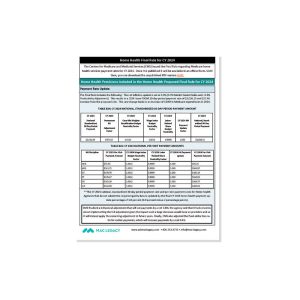The issuance of the Home Health Final Rule brings with it the opportunity to re-evaluate the financial position of your agency. If your agency has not yet begun to analyze this data, in particular the updated comorbidity adjustments, let me help you with a brief update. According to the final rule, only those subgroups of…
The issuance of the Home Health Final Rule brings with it the opportunity to re-evaluate the financial position of your agency.
If your agency has not yet begun to analyze this data, in particular the updated comorbidity adjustments, let me help you with a brief update.
According to the final rule, only those subgroups of diagnoses that represent more than 0.1 percent of periods of care and that have at least as high as the median resource use will receive a low comorbidity adjustment. This is based on the knowledge that the average number of comorbidities in the aggregate becomes the standard within that population for the purpose of payment. However, because we still expect HHAs to report all secondary diagnoses that affect care planning, there will be comorbidity subgroups included in the home health-specific list that do not meet the criteria to receive an adjustment.
For 2024, the Low Comorbidity Adjustment Subgroups remained at 22, but not without changes.
The following were removed from the low comorbidity adjustment subgroup, meaning if this diagnosis is listed as a comorbid diagnosis under slot 2-25, then you will no longer gain a low comorbidity adjustment.
- Gastrointestinal 1 – Crohn’s, Ulcerative Colitis, and other Functional Intestinal Disorders
- Musculoskeletal 2 – Rheumatoid Arthritis
- Neoplasm 6 – Malignant neoplasms of trachea, bronchus, lung, and mediastinum
These were added to the low comorbidity adjustment subgroups:
- Neoplasms 17 – Secondary neoplasms of respiratory and GI systems
- Neurological 4 – Alzheimer’s disease and related dementias (including G30.9 Alzheimer’s disease, unspecified)
- Respiratory 10 – 2019 Novel Coronavirus (U07.1 COVID-19)
The High Comorbidity Adjustment Subgroups increased from 91 to 102 for 2024. This means that there are 11 more opportunities to garner a high comorbidity adjustment than in 2023. Let’s look at a couple of those changes.
You will now garner a high comorbidity adjustment for the combination of the following codes in position 2-25 on your claim:
- Behavioral 4 – Psychotic, major depressive, and dissociative disorders (including unspecified dementia, eating disorder and intellectual disabilities)/Neurological 5 – Spinal Muscular Atrophy, Systemic atrophy, and Motor Neuron Disease (includes Parkinson’s and Parkinsonism)
- Cerebral 4 – Sequelae of Cerebrovascular Diseases, includes Cerebral Atherosclerosis and Stroke Sequelae (Late effects of a stroke)/Circulatory 2 – Hemolytic, Aplastic, and Other Anemias (includes unspecified anemia and anemia in chronic kidney disease)
The ability to ensure accurate coding and account for all comorbid diagnoses can have a significant impact on your payment. Case mix weight is increased by approximately 6% with a low comorbidity adjustment add on and around 13% if a high comorbidity adjustment is applied to the 30-day billing period.
Consider your organization’s strengths and weaknesses. Does your team fully understand low and high comorbidity adjustments?
Consider a coding audit by MAC Legacy or a personalized education session for your agency to more fully understand the strategies to improve reimbursement.
-
 Home Health Final PPS Rule for CY 2024 Cheat Sheet$0.00
Home Health Final PPS Rule for CY 2024 Cheat Sheet$0.00 -
 Coding & OASIS Review Credits$125.00 – $2,500.00
Coding & OASIS Review Credits$125.00 – $2,500.00
